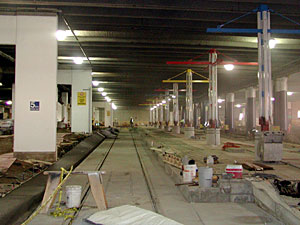|
Audio
Photos
More from MPR
Your Voice
|
Getting the buses on board with light rail
April 21, 2004
 |
| Most of the track has been laid at the Mall of America light-rail station in Bloomington for the projected December startup of service (MPR Photo/Dan Olson) |
Bloomington, Minn. — Think of Minneapolis bus service as a bicycle wheel. There's a hub -- downtown Minneapolis -- and spokes radiating outward. One of the new spokes is the Hiawatha light-rail line that runs from downtown southeast to the Mall of America in Bloomington.
Metro Transit spokesman Bob Gibbons says the bus realignment keeps the hub and spoke arrangement but adds a batch of cross town or east west service that cuts across the spokes. Gibbons says some bus routes will expanded, others reduced, and a few eliminated. The goal in most instances, he says is to have the bus lines intersect with light rail stations. "There'll be connecting bus service at every light rail in the first phase between downtown and Fort Snelling except at Cedar Riverside," Gibbons says, "So every train station will have coordinated bus service as well."
The bus realignment is an attempt to integrete bus and rail service so that one compliments the other.
There are 17 stations on the Hiawatha light-rail line. In one case, seven bus routes will feed the 46th Street station. Gibbons says some bus riders will hop the train there, others will transfer to other cross-town buses. The result, he says, is expanded bus service to many areas where it's been light or non-existent in the past.
"Some customers will come to the 46th Street light-rail station on buses simply to connect with other buses. One of the criticisms of public transportation in the past," Gibbons says, "has been in order to go from one neighborhood to the neighborhood next door you have to go downtown to make a connection. The development of light rail allows us to develop new and stronger cross-town services."
Gibbons says another piece of the bus route realignment expandes service along more 494 in Bloomington and Richfield, a major commercial artery with larger employers.
The busiest bus and train station on the Hiawatha light-rail line is under construction at the Mall of America transit center in Bloomington. Workers white hard hats, wearing bright yellow safety vests are pouring concrete for the train platform.
Light-rail construction spokesman Josh Collins says riders will get on and off trains next to the Mall. "They'll then continue around a sidewalk we're building over there and into the transit center much as they used to when the buses were the main mode in here," Collins says.
When construction is complete in December, the Mall's Transit Center will be served by light rail and a dozen city and suburban bus lines.
It's a more expensive station than an earlier plan. The extra cost is because of additional track bringing riders much closer to the Mall than the first design.
The additional cost is $40 million. Federal Transportation Administration officials agreed to pick up most of the increase. Officials say the construction cost for the 11.6-mile-long Hiawatha line is $715 million.
The Metro Transit bus realignment is made possible with a $14 million federal grant spread over three years.
An issue light-rail officials had to negotiate with the Mall owners and neighborhoods along the line is how to cope with commuters poaching parking spots intended for shoppers or residents.
"We've done a lot of work with the community, how they can come up with plans, parking structures or permit parking to keep people from leaving their car in front of their house and taking it into work," Josh Collins says.
Collins says there's a 600-car park-and-ride lot, a transit station near the Mall of America. However, the experience at other Twin Cities park and ride transit centers is commuter demand quickly outpaces the supply of parking spots with cars spilling over into adjacent areas.
|
News Headlines
|
Related Subjects
|
